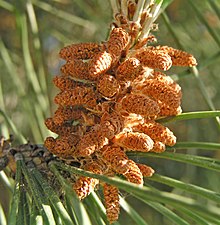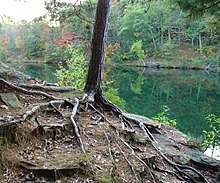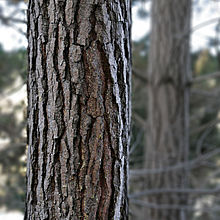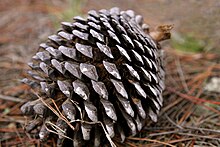
A pine is any conifer tree or shrub in the genus Pinus of the family Pinaceae. Pinus is the sole genus in the subfamily Pinoideae.

The term bristlecone pine covers three species of pine tree. All three species are long-lived and highly resilient to harsh weather and bad soils. One of the three species, Pinus longaeva, is among the longest-lived life forms on Earth. The oldest of this species is more than 4,800 years old, making it the oldest known individual of any species. Many scientists are curious as to why this tree is able to live so long. In one study, they discovered that Pinus longaeva has higher levels of telomerase activity, which further slows or prevents the attrition rate of telomeres. This potentially contributes to the extended life of the bristlecone pine.
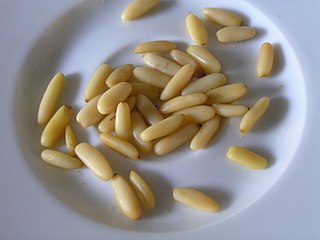
Pine nuts, also called piñón, pinoli, or pignoli, are the edible seeds of pines. According to the Food and Agriculture Organization, only 29 species provide edible nuts, while 20 are traded locally or internationally owing to their seed size being large enough to be worth harvesting; in other pines, the seeds are also edible but are too small to be of notable value as human food. The biggest producers of pine nuts are China, Russia, North Korea, Pakistan and Afghanistan.

The pinyon or piñon pine group grows in southwestern North America, especially in New Mexico, Colorado, Arizona, and Utah, with the single-leaf pinyon pine just reaching into southern Idaho. The trees yield edible nuts, which are a staple food of Native Americans, and widely eaten as a snack and as an ingredient in New Mexican cuisine. The name comes from the Spanish pino piñonero, a name used for both the American varieties and the stone pine common in Spain, which also produces edible nuts typical of Mediterranean cuisine. Harvesting techniques of the prehistoric American Indians are still used today to collect the pinyon seeds for personal use or for commercialization. The pinyon nut or seed is high in fats and calories. In the western United States, pinyon pines are often found in pinyon–juniper woodlands.

Pinus pumila, commonly known as the Siberian dwarf pine, dwarf Siberian pine, dwarf stone pine, Japanese stone pine, or creeping pine, is a tree in the family Pinaceae native to northeastern Asia and the Japanese isles. It shares the common name creeping pine with several other plants.
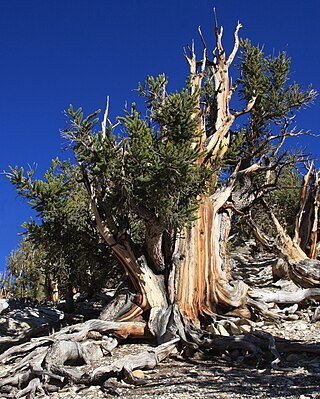
Pinus longaeva is a long-living species of bristlecone pine tree found in the higher mountains of California, Nevada, and Utah. Methuselah is a Great Basin bristlecone pine that is 4,856 years old and has been credited as the oldest known living non-clonal organism on Earth. To protect it, the exact location of this tree is kept secret. In 1987, the bristlecone pine was designated one of Nevada's state trees.

Pinus cembroides, also known as pinyon pine, Mexican pinyon, Mexican nut pine, and Mexican stone pine, is a pine in the pinyon pine group.

Pinus remota, commonly known as the Texas pinyon or papershell pinyon, is a pine in the pinyon pine group, native to southwestern Texas and northeastern Mexico. It can be distinguished from other pinyon species by its thin-walled seeds, which made it especially attractive as a food to Indians and Mexicans living where it grew. Spanish explorer Cabeza de Vaca noted that the papershell pinon was an important food for the Indians in 1536.

Pinus monophylla, the single-leaf pinyon, is a pine in the pinyon pine group, native to North America. The range is in southernmost Idaho, western Utah, Arizona, southwest New Mexico, Nevada, eastern and southern California and northern Baja California.

Pinus aristata, the Rocky Mountain bristlecone pine or Colorado bristlecone pine is a long-lived species of bristlecone pine tree native to the United States. It is found in the Rocky Mountains in Colorado and northern New Mexico, with an isolated population in the San Francisco Peaks of Arizona. It is found at very high altitudes, from 2,100 to 4,000 meters in cold, dry subalpine climate conditions, often at the tree line, although it also forms extensive closed-canopy stands at somewhat lower elevations.

Pinus thunbergii, the black pine, Japanese black pine, or Japanese pine, is a pine tree native to coastal areas of Japan and South Korea.

Abert's squirrel or the tassel-eared squirrel is a tree squirrel in the genus Sciurus native to the southern Rocky Mountains from the United States to the northern Sierra Madre Occidental of Mexico, with concentrations found in Arizona, New Mexico, and southwestern Colorado. It is closely associated with, and largely confined to, mature ponderosa pine forests. It is named in honor of the American naturalist John James Abert; nine subspecies are recognised. It is recognizable by its tufted ears, gray color, pale underparts and rufous patch on the lower back. The squirrel feeds on the seeds and cones of the Mexican pinyon and the ponderosa pine when they are available, but will also take fungi, buds, bark, and carrion. Breeding normally occurs in summer, with a spherical nest being built high in the canopy.

The Sierra Madre Occidental pine–oak forests are a Temperate broadleaf and mixed forests ecoregion of the Sierra Madre Occidental range from the southwest USA region to the western part of Mexico. They are home to a large number of endemic plants and important habitat for wildlife.

Pinus hartwegii, Hartweg's pine, the Mexican mountain pine, or pino de las alturas, is a pine native to the mountains of Mexico and Central America east to Honduras. It is named after Karl Theodor Hartweg, who described it in 1838.

The pinyon jay is a species of jay, and is the only member of the genus Gymnorhinus. Native to Western North America, the species ranges from central Oregon to northern Baja California, and eastward as far as western Oklahoma, though wanderers are often sighted beyond this range. It is typically found within foothills, especially where pinyon pines occur.
The Pine–oak Forest of Puebla covers the mass of pine and oak forests in the Mexican state of Puebla.
Both naturally and artificially occurring pine species (Pinus) can hybridize, combining their genetic material and sometimes creating hybrids that can be more or less vigorous than their parent species. An example of a naturally occurring hybrid pine is Pinus × sondereggeri, a naturally occurring cross between loblolly pine and longleaf pine. An example of the many artificial hybrids is Pinus lambertiana × P. armandii.

